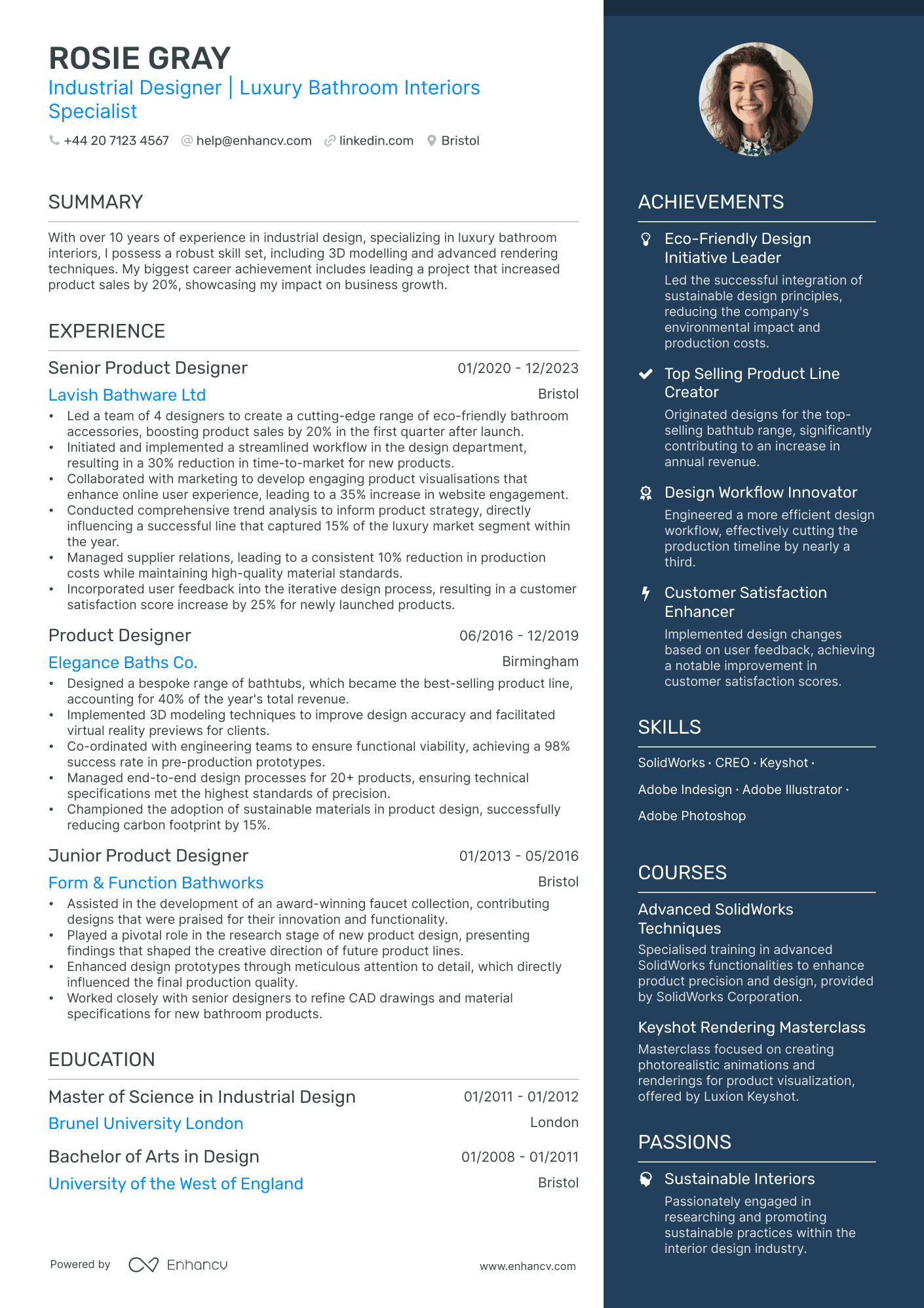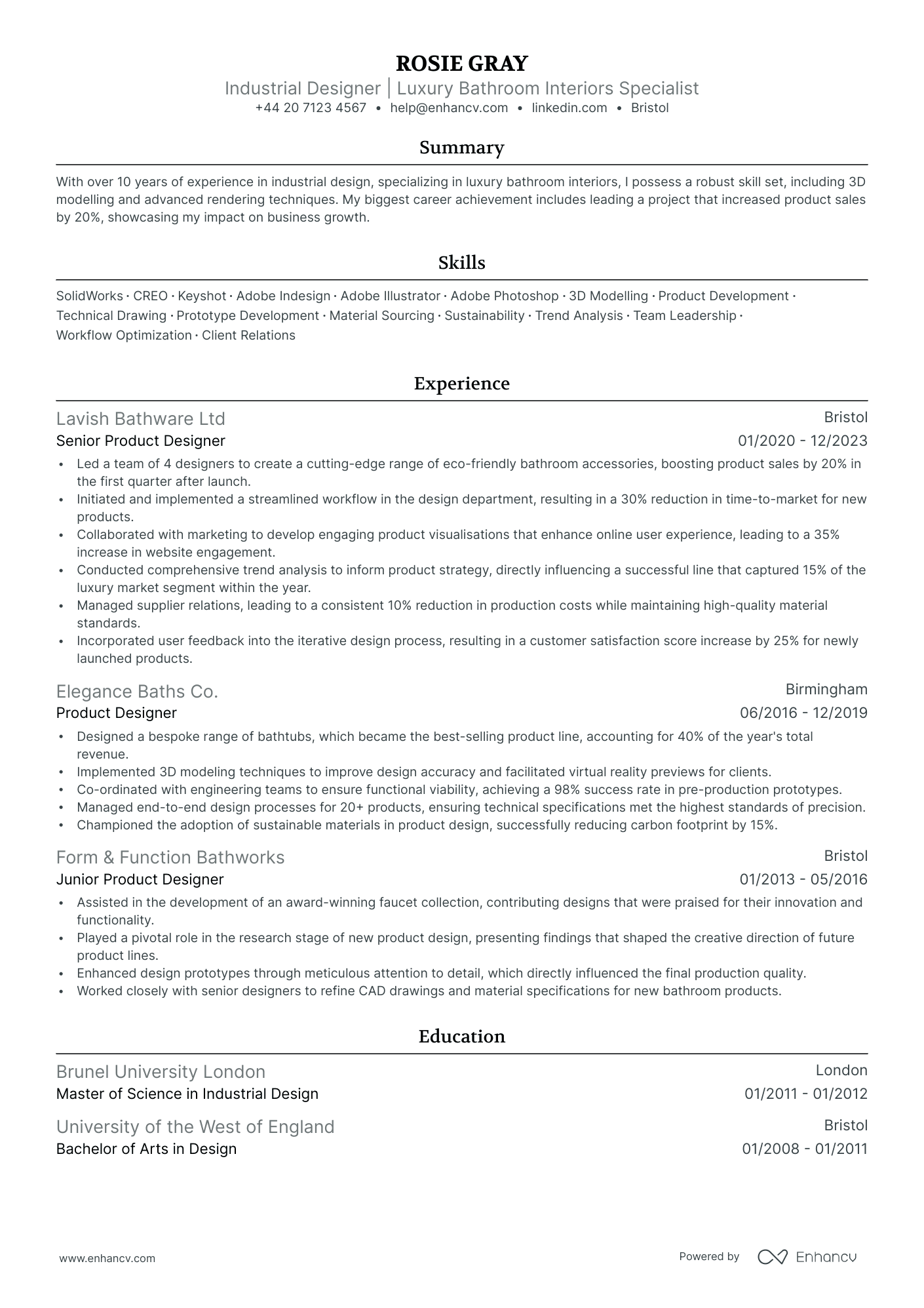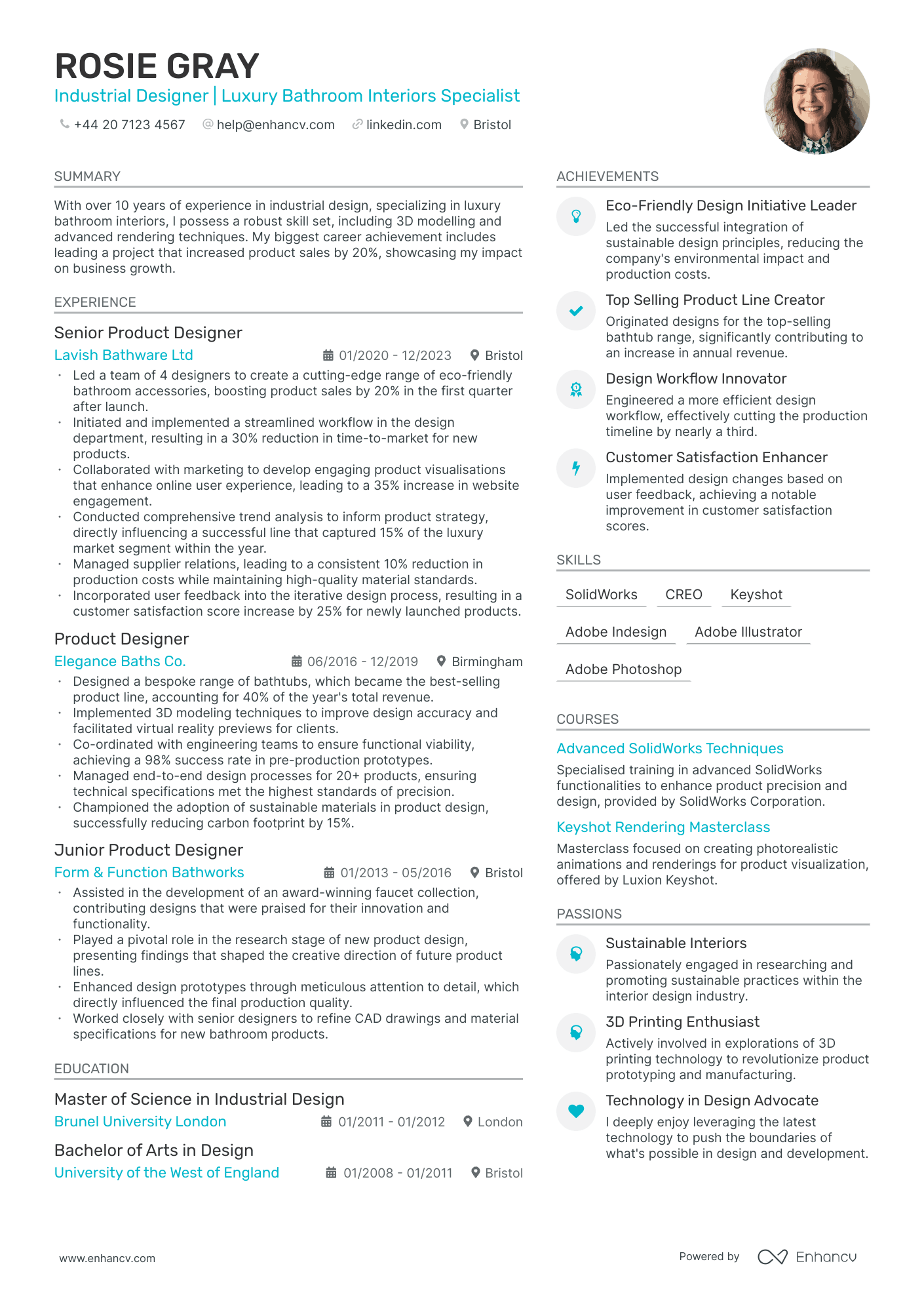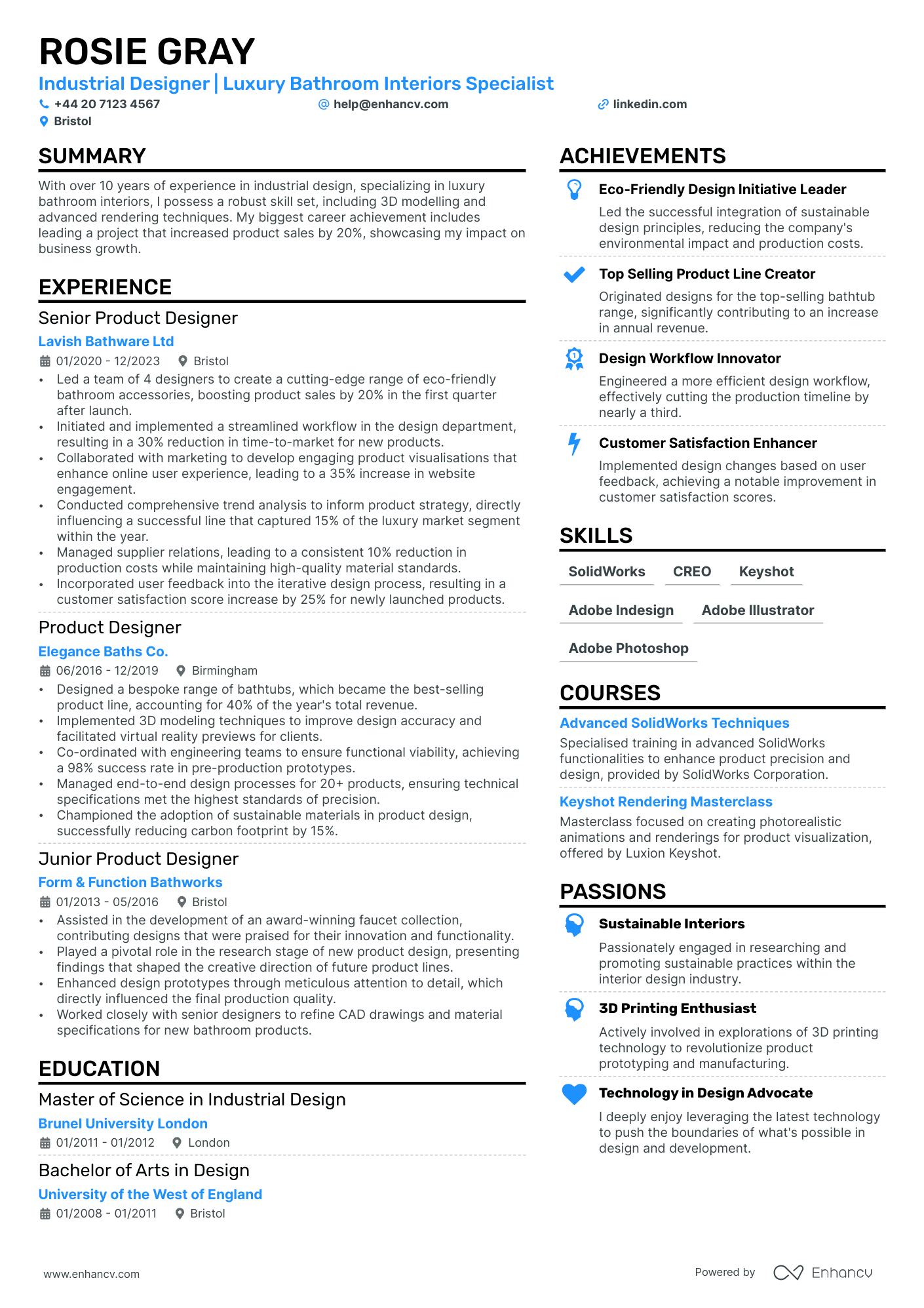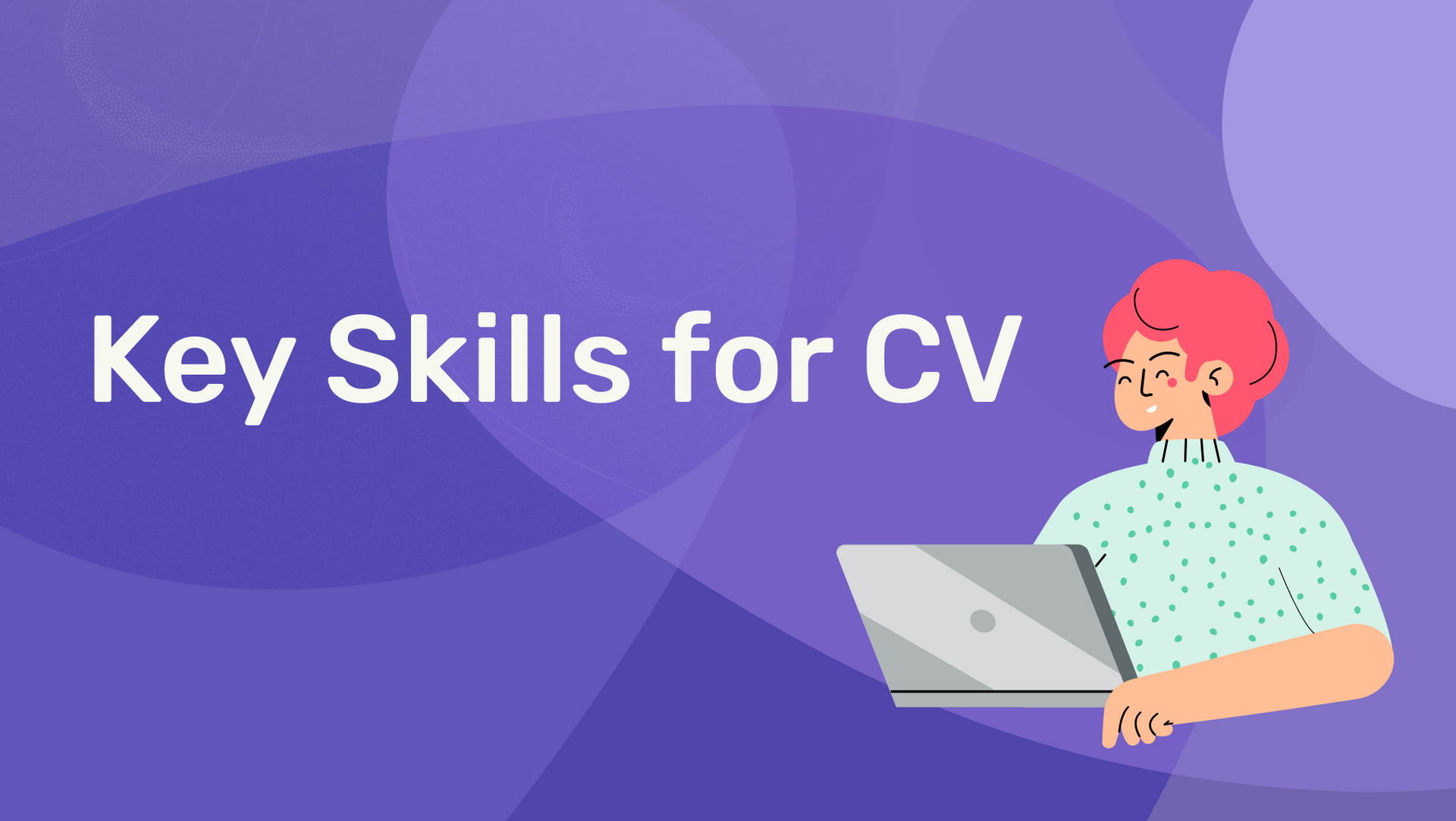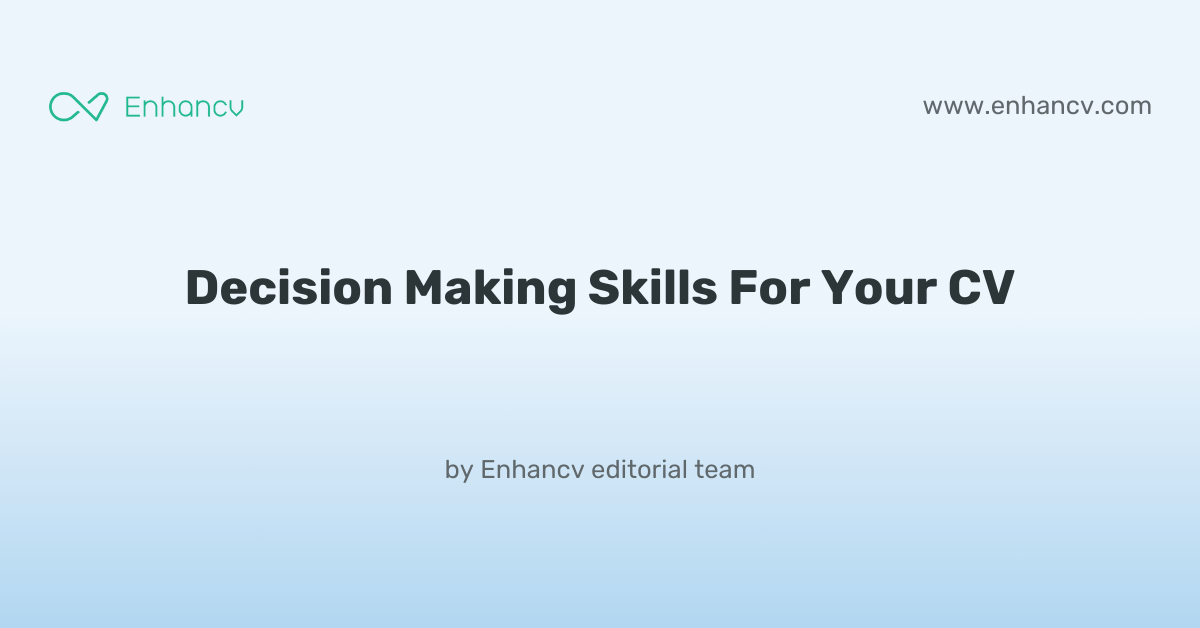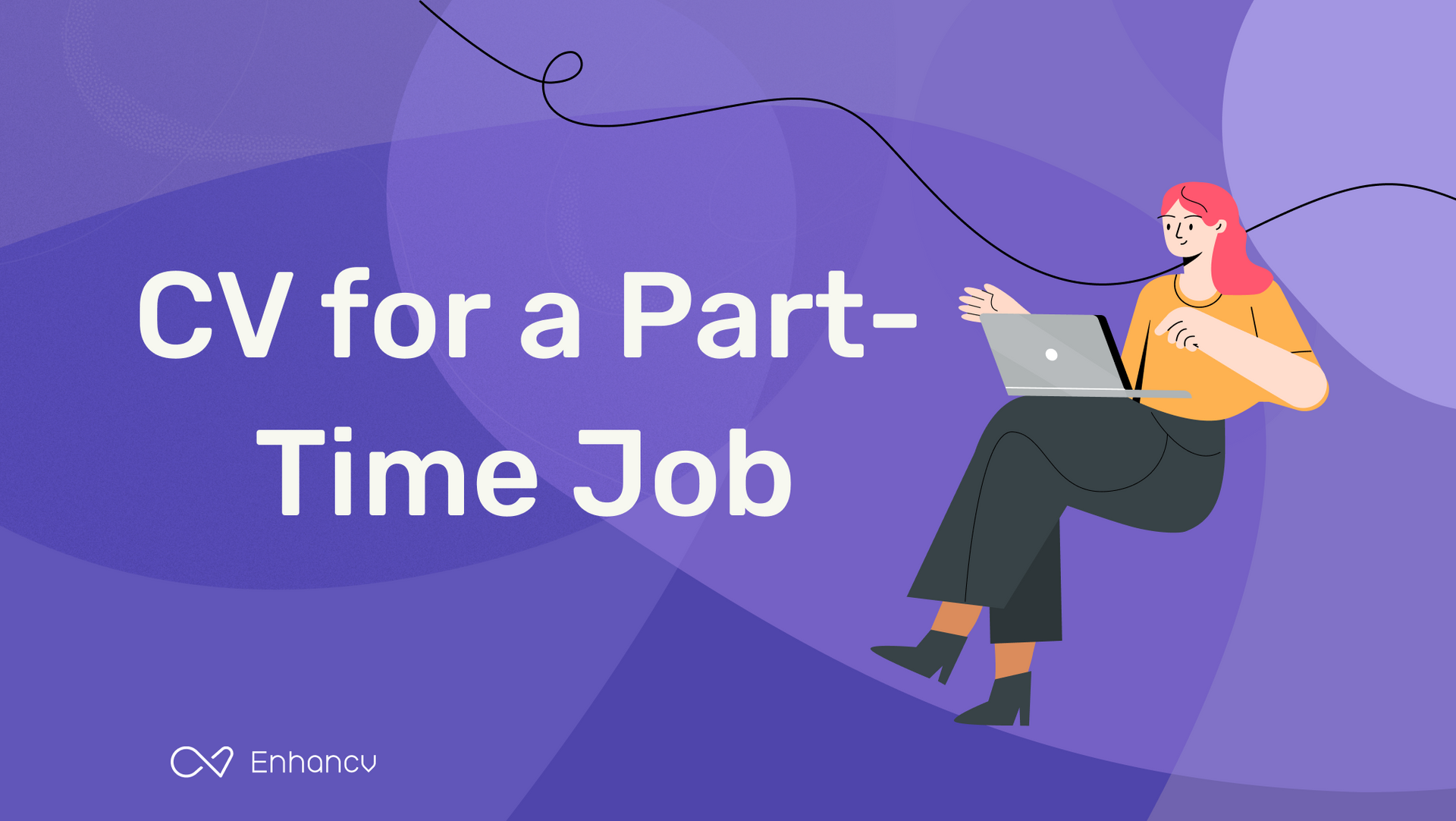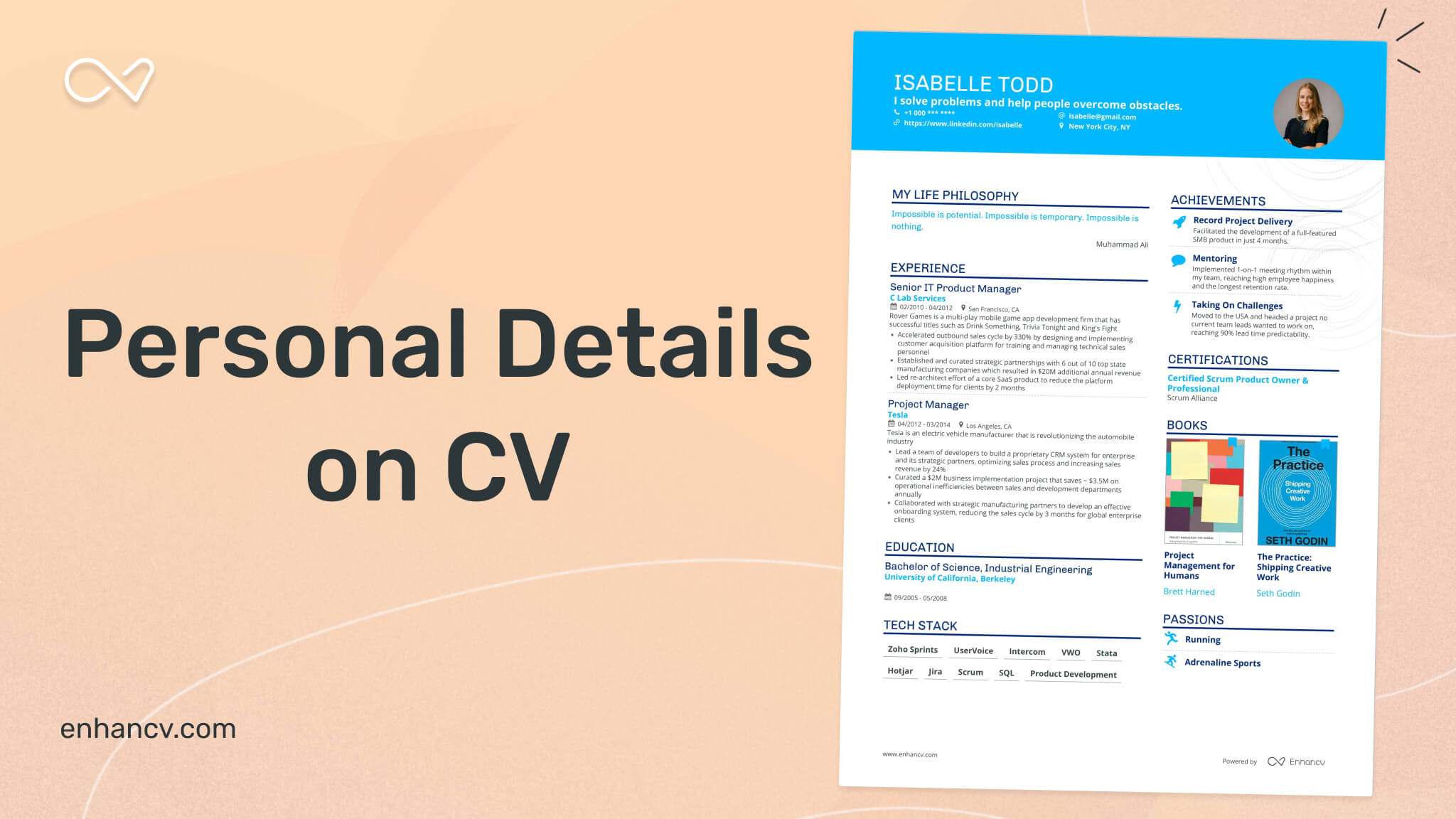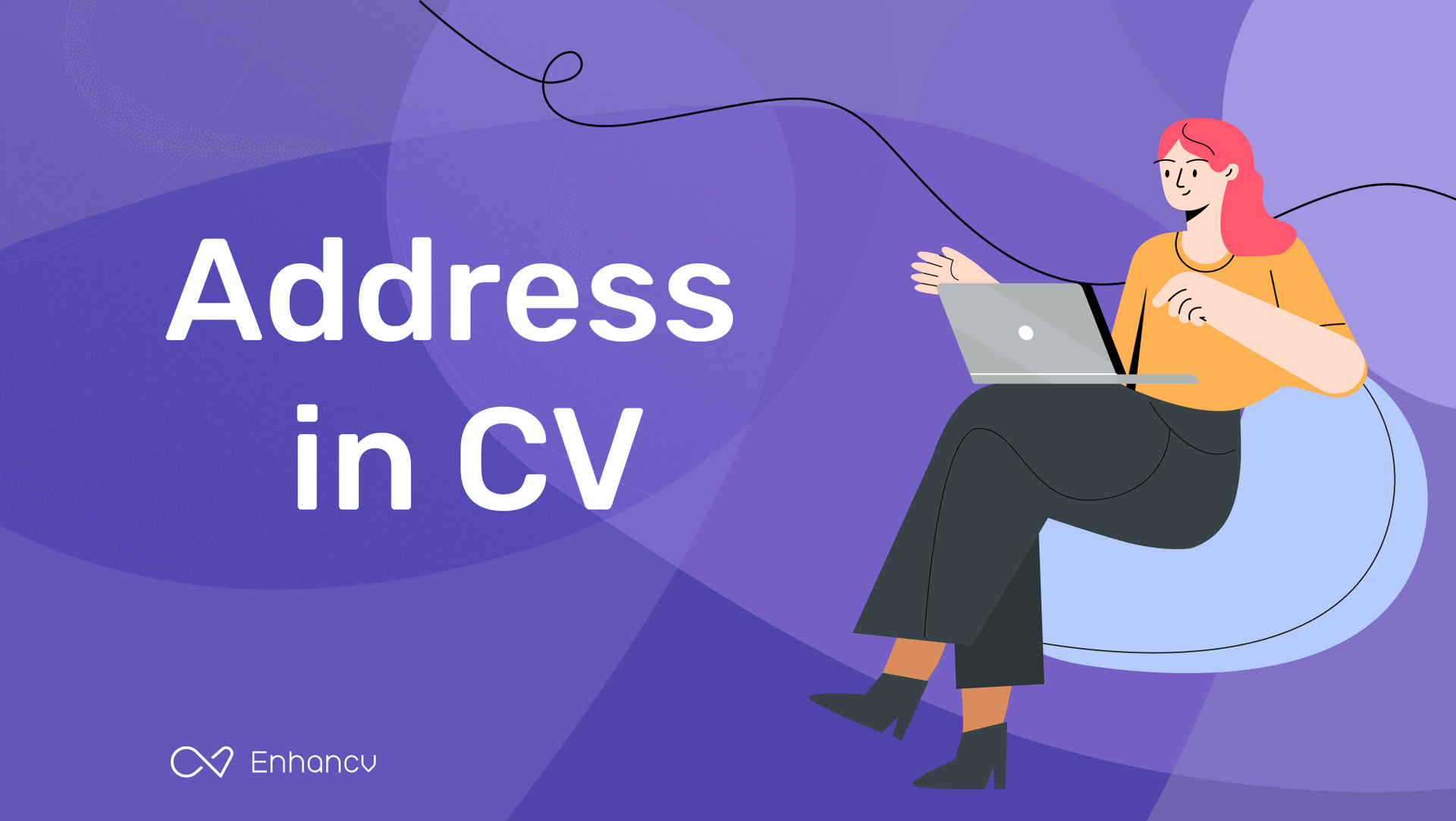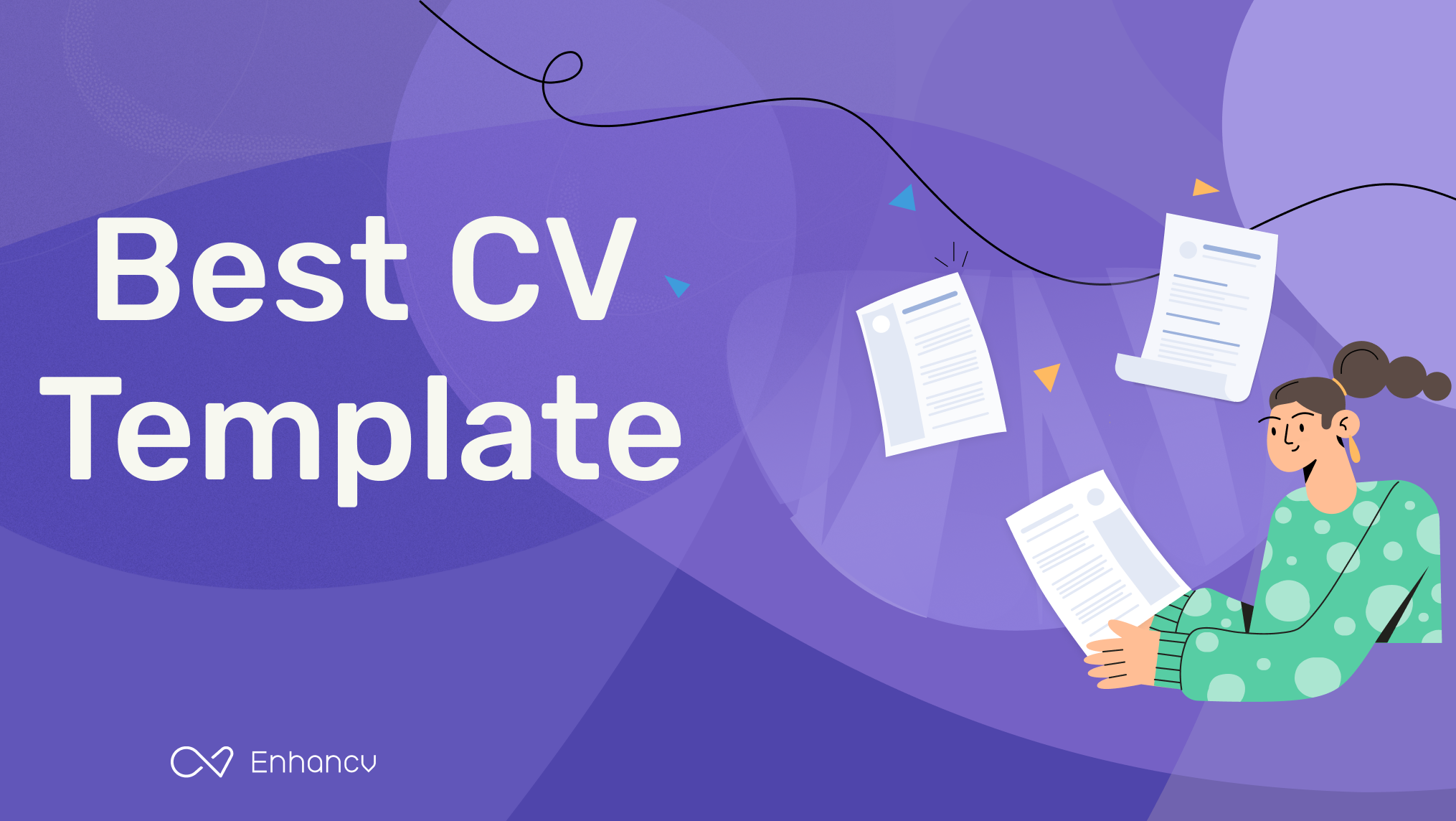Creating a comprehensive and impactful CV is a perennial challenge in the field of industrial design, as you need to effectively showcase your creativity and technical proficiency. Our guide will provide you with tailored advice to highlight your unique skill set and ensure your portfolio captures the attention of potential employers or clients.
- Applying the simplest CV design, so that recruiters can easily understand your expertise, skills, and professional background;
- Ensuring you stand out with your header, summary or objective statement, and a designated skills section;
- Creating your CV experience section - no matter how much expertise you have;
- Using real life professional CV examples to enhance the structure and outline of your profile.
If you still have no muse to write your professional CV, find some more industry-leading examples.
Structuring your industrial design CV layout: four factors to keep in mind
There are plenty of best practices out there for your CV layout and design. At the end of the day, a clear format and concise CV message should be your top priority. Use your CV design to enhance separate sections, bringing them to the forefront of recruiters' attention. At the same time, you can write content that:- Follows the reverse chronological order in the experience section by first listing your most recent jobs;
- Incorporates your contact information in the header, but do skip out on the CV photo for roles in the UK;
- Is spotlighted in the most important sections of your CV, e.g. the summary or objective, experience, education, etc. to show just how you meet the job requirements;
- Is no longer than two-pages. Often, the one-page format can be optimal for your industrial design CV.
Before submitting your CV, you may wonder whether to export it in Doc or PDF. With the PDF format, your information and layout stay intact. This is quite useful when your CV is assessed by the Applicant Tracker System (or the ATS) . The ATS is a software that scans your profile for all relevant information and can easily understand latest study on the ATS , which looks at your CV columns, design, and so much more.
PRO TIP
Incorporate a touch of colour in headers or section breaks, but keep it professional and ensure it doesn’t detract from readability, especially in more conservative industries.
The top sections on a industrial design CV
- Contact information to promptly reach the candidate.
- Portfolio of design work for appraisal of creativity.
- Work experience illustrating hands-on industry knowledge.
- Relevant education to establish design foundations.
- Skills section covering technical and design expertise.
What recruiters value on your CV:
- Showcase your design process by illustrating how you approach projects from conception through to final product, including the research, sketching, prototyping, and user testing phases.
- Demonstrate your proficiency in relevant software such as Adobe Creative Suite, Sketch, SolidWorks, or other industrial design tools, mentioning specific tools used for different projects.
- Feature a portfolio link prominently on your CV, as visual evidence of your work is crucial in industrial design; ensure the portfolio is professionally presented and up-to-date.
- Highlight any experience with interdisciplinary collaboration by detailing projects where you worked with engineers, marketing teams, or other designers to develop a cohesive product.
- Emphasise your understanding of manufacturing processes and materials, including any hands-on experience or projects that resulted in mass-produced items.
Recommended reads:
Making a good first impression with your industrial design CV header
Your typical CV header consists of Your typical CV header consists of contact details and a headline. Make sure to list your professional phone number, email address, and a link to your professional portfolio (or, alternatively, your LinkedIn profile). When writing your CV headline , ensure it's:
- tailored to the job you're applying for;
- highlights your unique value as a professional;
- concise, yet matches relevant job ad keywords.
You can, for examples, list your current job title or a particular skill as part of your headline. Now, if you decide on including your photo in your CV header, ensure it's a professional one, rather than one from your graduation or night out. You may happen to have plenty more questions on how to make best the use of your CV headline. We'll help you with some real-world examples, below.
Examples of good CV headlines for industrial design:
- Lead Product Designer | User-Centred Innovation | CAD Expert | Chartered Designer | 10+ Years Experience
- Junior Industrial Designer | Ergonomic Focus | Prototyping Enthusiast | MA in Design | Emerging Talent
- Senior Industrial Designer | Strategic Product Development | Sustainability Advocate | BSc & BA | 15 Years Deep Expertise
- Creative Director | Industrial Aesthetics Specialist | Cross-functional Team Leader | CSD Certified | 20 Years Leadership
- Mid-Level Industrial Designer | Consumer Electronics Expert | 3D Modelling & Rendering | 5 Years Progressive Experience
- Innovative Design Engineer | Material Science Integration | IP Development | MDes Design Innovation | 8 Years Industry Visionary
Opting between a industrial design CV summary or objective
Within the top one third of your industrial design CV, you have the opportunity to briefly summarise your best achievements or present your professional goals and dreams. Those two functions are met by either the CV summary or the objective.
- The summary is three-to-five sentences long and should narrate your best successes, while answering key requirements for the role. Select up to three skills which you can feature in your summary. Always aim to present what the actual outcomes were of using your particular skill set. The summary is an excellent choice for more experienced professionals.
- The objective is more focused on showcasing your unique value as a candidate and defining your dreams and ambitions. Think about highlighting how this current opportunity would answer your career vision. Also, about how you could help your potential employers grow. The objective matches the needs of less experienced candidates, who need to prove their skill set and, in particular, their soft skills.
Still not sure about how to write your CV opening statement? Use some best industry examples as inspiration:
CV summaries for a industrial design job:
The best formula for your industrial design CV experience section
The CV experience section is the space where many candidates go wrong by merely listing their work history and duties. Don't do that. Instead, use the job description to better understand what matters most for the role and integrate these keywords across your CV. Thus, you should focus on:
- showcasing your accomplishments to hint that you're results-oriented;
- highlighting your skill set by integrating job keywords, technologies, and transferrable skills in your experience bullets;
- listing your roles in reverse chronological order, starting with the latest and most senior, to hint at how you have grown your career;
- featuring metrics, in the form of percentage, numbers, etc. to make your success more tangible.
When writing each experience bullet, start with a strong, actionable verb, then follow it up with a skill, accomplishment, or metric. Use these professional examples to perfect your CV experience section:
Best practices for your CV's work experience section
- Quantify achievements in your projects, such as increasing product usability by a certain percentage or reducing manufacturing costs, to provide tangible evidence of your impact on design efficiency.
- Highlight experience with CAD software and rapid prototyping tools, detailing the specific software you are proficient in and how you've applied them in your designs.
- Showcase your understanding of materials and production processes, citing examples where you've selected optimal materials for durability and cost-effectiveness.
- Illustrate your problem-solving skills by describing a challenging project and how you applied design thinking to arrive at a viable solution.
- Emphasise any collaborative projects, underscoring your ability to work with cross-functional teams, including engineers, marketers, and production staff.
- Include successful designs that went to market, mentioning any patents, design awards, or recognitions your work has received, to establish your credibility.
- Discuss your involvement in user research and how you integrate feedback into your design process to create user-centered products.
- Mention any sustainability initiatives you've been part of, such as eco-friendly designs or lifecycle analysis, to demonstrate your commitment to environmentally responsible design practices.
- Detail your proficiency in design regulations and standards, offering examples of how you've ensured compliance in your product designs.
- Led the design overhaul of a flagship consumer electronics product, enhancing usability and aesthetic appeal which boosted customer satisfaction ratings by 35%.
- Implemented cost-saving material substitutions across multiple product lines, saving the company an estimated £250k annually in production costs.
- Collaborated with a cross-functional team to deliver a complex industrial design for a new-to-market medical device, shortening the product development cycle by 4 months.
- Conceptualised and executed the industrial design for a series of award-winning home appliances, leading to a 20% increase in market share.
- Drove the adoption of 3D prototyping techniques that improved the iteration speed of new product designs by 50%.
- Mentored a team of junior designers, fostering an environment of innovation and helping to launch the careers of 5 industrial design professionals.
- Streamlined the industrial design process through the integration of user experience (UX) principles, increasing client satisfaction by 40%.
- Led design efforts for an industrial machinery project, which enhanced operational efficiency by 25% through ergonomic improvements.
- Generated full lifecycle designs for a portfolio of successful consumer electronics, directly contributing to a yearly revenue increase of approximately £5 million.
- Directed and executed a sustainable design strategy, resulting in the development of an eco-friendly packaging solution that reduced plastic waste by 70%.
- Pioneered a collaborative project with engineering to create an innovative construction vehicle, enhancing safety features and surpassing industry standards.
- Facilitated workshops to ideate new product concepts, successfully pitching 3 new designs that expanded the company's portfolio into new markets.
- Revitalized the product design for a range of professional power tools, which grew the customer base by 30% within the first year post-launch.
- Developed and implemented a modular design system that expedited the production time by 20%, effectively increasing the speed-to-market for new products.
- Organized cross-departmental efforts to align industrial design practices with manufacturing constraints, optimizing the production process for enhanced efficiency.
- Redesigned a line of commercial refrigeration units, meeting stringent energy efficiency standards, leading to a 15% reduction in energy consumption for end-users.
- Cultivated a user-centered design philosophy within the team, ensuring all projects met high standards of functionality and user engagement.
- Secured 4 patents for innovative design features that were incorporated into next-generation home appliances, solidifying the company's intellectual property portfolio.
- Led the transformation of user research insights into practical design solutions, resulting in products that consistently exceeded customer expectation metrics by over 30%.
- Spearheaded a cost-reduction initiative by redesigning product components for automated assembly, reducing labour costs by 20%.
- Enhanced the company's competitive edge by integrating smart technology into traditional appliances, which saw a 25% uplift in sales for the smart product range.
- Catalyzed the company's move into wearable technology by heading the design of a smart watch that achieved a 10% market penetration within its first year.
- Redefined production quality standards by introducing advanced materials to the design phase, enhancing product durability and customer loyalty.
- Developed an industry-recognized design language that increased brand recognition and contributed to a 20% uplift in overall sales.
What to add in your industrial design CV experience section with no professional experience
If you don't have the standard nine-to-five professional experience, yet are still keen on applying for the job, here's what you can do:
- List any internships, part-time roles, volunteer experience, or basically any work you've done that meets the job requirements and is in the same industry;
- Showcase any project you've done in your free time (even if you completed them with family and friends) that will hint at your experience and skill set;
- Replace the standard, CV experience section with a strengths or achievements one. This will help you spotlight your transferrable skills that apply to the role.
Recommended reads:
PRO TIP
If applicable, briefly mention a situation where things didn’t go as planned and what you learned from it, demonstrating your ability to learn and adapt.
Hard skills and soft skills to showcase your unique skill set on your industrial design CV
Did you know that your CV will mostly likely be assessed by recruiters based on skill alignment? And that means that the way you feature your key skills across different CV sections will play a crucial role in landing you that first interview. We recommend you add your:
- technical capabilities or hard skills in your CV experience, certificates, projects, etc. Use your past accomplishments to prove your technical capabilities. List up to a dozen different software or hardware in your dedicated skills section to match the job keywords;
- personal and communication skills or soft skills in your CV strengths, achievements, summary/ objective, etc. Soft skills are a bit more difficult to prove. How do you define your aptitude in active listening? So, instead of just listing the skill name, include a tangible metric to show your success.
On a final note, when you're in a hurry to create your profile, you may misspell a particular technology or soft skill. That's why we suggest you copy and paste the particular skill name (or keyword), directly from the job advert. This would also help you to pass any initial Applicant Tracker System (ATS) tests.
Top skills for your industrial design CV:
3D Modelling
Prototyping
CAD Software Proficiency
Materials Knowledge
Sketching
Product Development Process
User-Centered Design
Adobe Creative Suite
Model Making
Ergonomics
Creativity
Problem-Solving
Collaboration
Visual Communication
Attention to Detail
Critical Thinking
Adaptability
Time Management
Empathy
Presentation Skills
PRO TIP
Use mini case studies or success stories in your CV to demonstrate how your skills have positively impacted previous roles or projects.
Further professional qualifications for your industrial design CV: education and certificates
As you're nearing the end of your industrial design CV, you may wonder what else will be relevant to the role. Recruiters are keen on understanding your academic background, as it teaches you an array of hard and soft skills. Create a dedicated education section that lists your:
- applicable higher education diplomas or ones that are at a postgraduate level;
- diploma, followed up with your higher education institution and start-graduation dates;
- extracurricular activities and honours, only if you deem that recruiters will find them impressive.
Follow a similar logic when presenting your certificates. Always select ones that will support your niche expertise and hint at what it's like to work with you. Balance both technical certification with soft skills courses to answer job requirements and company values. Wondering what the most sought out certificates are for the industry? Look no further:
PRO TIP
If there's a noticeable gap in your skillset for the role you're applying for, mention any steps you're taking to acquire these skills, such as online courses or self-study.
Recommended reads:
Key takeaways
Write your professional industrial design CV by studying and understanding what the role expectations are. You should next:
- Focus on tailoring your content to answer specific requirements by integrating advert keywords through various CV sections;
- Balance your technical know-how with your personal skills to showcase what the unique value would be of working with you;
- Ensure your CV grammar and spelling (especially of your key information and contact details) is correct;
- Write a CV summary, if your experience is relevant, and an objective, if your career ambitions are more impressive;
- Use active language by including strong, action verbs across your experience, summary/objective, achievements sections.
